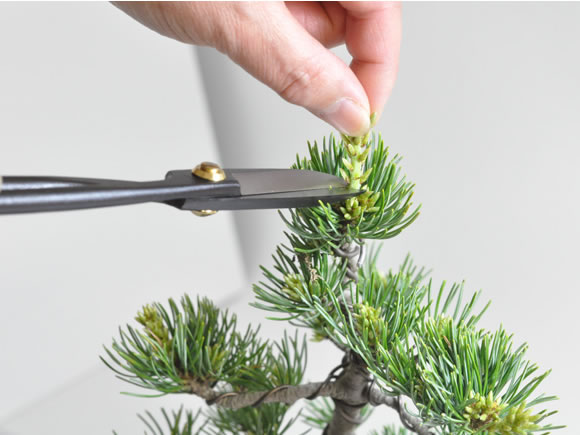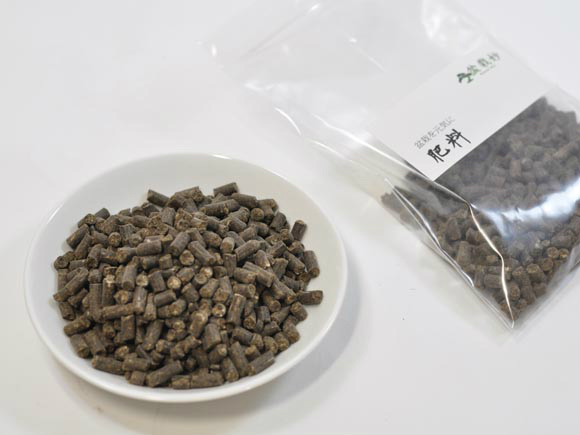
SHAPING BONSAI TREES
The styling of bonsai trees includes regular pruning and wiring, and also advanced techniques like creating deadwood. This page would give you detailed information about the Bonsai training techniques. Varieties of techniques have developed to train Bonsai trees and keep them in small figures. Pruning and wiring are the most essential ones, which you’ll be acquired by the time you finish reading this article.
PRUNING ~ shaping the tree by cutting blanches ~
There are two types of pruning: maintenance pruning and forming pruning. Knowing how the tree grows would help us understand how to prune more effectively. Trees are naturally tended to grow to the top and to outer(less) which is called “apical dominance”. This law of nature was developed to allow trees to grow higher in order to avoid being shaded out by other trees. As the tree grows, inner and lower blanches gradually dies. The main element to prune is to force tree to grow more inner and lower blanches.

Pruning as Maintenance
The goal of pruning as maintenance is to maintain and polish the figure of a tree. As mentioned above, trees grow more to the top and outer. That is why it is important to prune top and outer on a regular basis so as to encourage tree to grow more inner. This pruning could be done throughout the growth season. Well then, how? It is very simple. You just need to prune blanches and buds that have grown too much with twig shears (you can also use a normal scissors). You don’t need to be afraid, it is very important for tree to grow more evenly. Even if you cut too much blanches, tree is going to grow again. When you prune pine trees and conifers, you should pinch by hands. Pruning with scissors would cause brown foliage, which is basically dead. Hold the point of the bud with your thumb and pointing finger, and pull it away carefully, then bud will snap at the weakest spot. Tadaa! You prevent tree from brown foliage.
Pruning as forming
To form the tree into the shape you want, large blanches also have to be pruned. Deciding which blanches to remove and which ones to leave would be very tricky, because it is unalterable and it has some role of deciding how the tree would look like. When do you do this? In the early spring or late fall is about right time to prune a tree. Those timelines are just before and after growing seasons. Note that it may differ depending on the kind of tree. Then, how you do it? Put your bonsai on a flat place at eye-level and remove all the dead wood. Next thing you should do is to scrutinize the bonsai and decide which blanches should be removed to make the tree closed to the desired shape. There is no rule for deciding the future design, it is a creative procedure and it is entirely up to you! Bonsai style page would be able to help you though.
Finished pruning? Here are some things you need to do afterwards.
You should put your bonsai in the shade and out of the wind. Fertilize as usual and give tree the time to recover at least 2 or 3 months.

SHAPING BONSAI TREES
The styling of bonsai trees includes regular pruning and wiring, and also advanced techniques like creating deadwood. This page would give you detailed information about the Bonsai training techniques. Varieties of techniques have developed to train Bonsai trees and keep them in small figures. Pruning and wiring are the most essential ones, which you’ll be acquired by the time you finish reading this article.
WIRING ~ shaping the tree by wrapping wires~
Wiring is essential technique to train and form bonsai trees. When you wrap copper wire around blanches, you will be able to bend and shift blanches anyway you want. It will take a few months for tree to adapt to the new position and settle down. Copper wire should then be removed. This can be done throughout the year for most species. During the growing season blanches grow thicker very fast, so it can cause wire cutting into the bark. This would create serious scars, please check on your tree and remove wire if needed. Wondering which wire to use? There are two kinds of wire that can be used: anodised aluminium, and tempered copper. I recommend you to use anodised aluminium wires, because it is easier to work with and you can get it most of the bonsai shops. If you buy 1mm, 1.5mm, 2.5mm and 4mm, it will be pretty much perfect to start with.
Single-wiring ~wiring blanches separately~
In this technique, you need to cut wire into the right length. Wrap the wire45 degrees at least twice around the trunk. Try put wires neatly in line.
Double-wiring ~wiring 2 blanches with one wire~
First, choose the pair of blanches that are close and about the same thickness. The wire should be wrapped around the trunk at least once, preferably twice. So that the wire won’t move when you bend the blanches later. You should start wrapping around the trunk and go further to the first blanch. The blanch should be wrapped from base to the tip before you go on to the next blanch. Angle of wire should be 45 degrees. After you have wired suitable pairs of blanches, use the single-wiring technique to wire the rest of blanches.


















